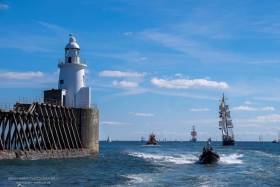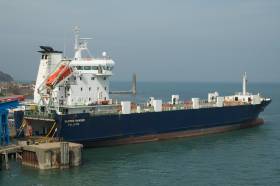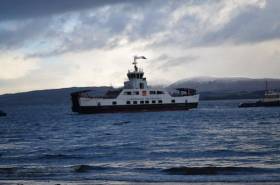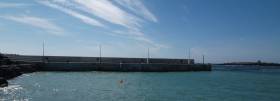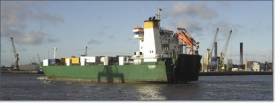Displaying items by tag: Ferry news
Irish Bulker Berths at Blyth Host of Tall Ships Race Diamond Anniversary
#TallShipsRace - Bulker Arklow Meadow departed Aughinish, Shannon Estuary last week bound for the Port of Blyth, where the UK port was host to the North Sea Tall Ships Race, writes Jehan Ashmore.
The Irish flagged Arklow Meadow had loaded at the Rusal Aughinish Alumina plant (see: sister report) from where the 'M' class 14,990dwt bulker departed to round Scotland. The bulker discharged at Blyth where the north-east English port has the Alcan Aluminium Ore Unloading Facility. The South Korean built bulker currently remains at this berth.
At the Northumberland port a spectacular line-up of around 30 entrants of the North Sea Tall Ships regatta gathered for the Parade of Sail and which this year celebrated a Diamond anniversary of the Tall Ships race movement. The North Sea event followed that of the main Tall Ships Race 2016, the prestigious annual race which is also organised by Sail Training International.
It is exactly sixty years since the very first Tall Ships Race visited Lisbon, Portugal in 1956 - an international fleet aptly made a return visit this year, having set off from Antwerp, Belgium. The winner of the Tall Ships Race 2016 was Norway’s Statsraad Lehmkuhl as previously reported on Afloat.ie which visited Dublin Port last month after a cruise-in company to Coruña, northern Spain.
Last week’s sailing spectacular of the North Sea Tall Ships Parade of Sail was held in glorious conditions on the UK’s Bank Holiday at the end of August. As the magnificent tallships departed the Port of Blyth, the Parade of Sail was observed by spectators lining the decks of Princess Seaways, a ferry operated by the Parade sponsor, DFDS Seaways. The Danish shipping company also had something to celebrate, as 2016 marks their 150th anniversary.
Princess Seaways, made the special four-hour cruise to Blyth from Newcastle, further south along the coast. Otherwise the 31,000 gross tonnage ferry normally operates the Newcastle-Amsterdam (Ijmuiden) along with route partner and a sister, King Seaways. The former Val de Loire served Brittany Ferries seasonal Cork-Roscoff route until replaced by current incumbent, Pont-Aven that entered service in 2004 (this year installed with 'scrubbers'). The flagship also operates year round on France-UK and UK-Spanish routes.
Among the North Sea Tall Ship Races participants that were observed from the ferry's cruise, was another Norwegian entrant, Christian Radich, Poland’s Dar Mlodziezy, the UK’s Lord Nelson and the Dutch Morgenster, a visitor to this summer’s Dublin Riverfest.
At the weekend the Tall Ships had completed the 500 nautical mile leg from Blyth having arrived at the Swedish Port of Gothenburg culminating the North Sea Tall Ships Race. This was the fifth occasion that Gothenburg has hosted the Tall Ships.
Seatruck Launch New Dublin-Bristol Route
#NewRoute - Seatruck Ferries, the Irish Sea’s dedicated unaccompanied freight operator, has begun a weekend service connecting Dublin and Bristol.
The UK west coast port, Bristol is a major hub for car imports, and the connection allows car manufacturers to enter Ireland directly without the need for a UK trunk. The new service uses a Seatruck ro-ro vessel that would otherwise be idle at the weekend.
The operator which celebrates its 20th year has a network of three routes: Heysham – Warrenpoint (their first route) Dublin-Heysham and Dublin-Liverpool.
With the summer just gone, this is normally a quieter period, however, Seatruck Ferries have reported strong growth and new service offerings on its Irish Sea routes. During August alone, shipment of unaccompanied trailers was 24.9% increase compared with the previous year.
By operating to Heysham and Liverpool, this allows freight operators using unaccompanied trailer shipments to use their drivers and equipment more efficiently.
The English ports providing significant road mileage savings compared with the traditional transit by other operators through ports in Wales and Scotland.
CalMac Unveils West Coast Ferry Plans for "New Era"
#NewEra - Scottish transport operator, CalMac has gone public for the first time with ambitious plans to transform west coast ferry services following formal granting of its new contract for the next eight years.
As reported on Afloat, CalMac was announced as the successful bidder for the Clyde and Hebrides Ferry Services (CHFS) tender in May, signed the contract with Transport Scotland on August 22 after finalisation of legal agreements. The contract begins on 1 October, 2016 and will run until 2024.
Scottish Ministers and Transport Scotland place great value on the contribution that the Clyde and Hebrides Service can make to the social, cultural and economic vitality of Scotland, and in particular in the Island and Coastal communities.
Managing Director, Martin Dorchester, said that CalMac's winning bid was rooted in ambitious plans to drive improvements which will transform the experience of ferry travellers, exemplify customer focus, and show the company's determination to make a positive difference to the communities.
The planned innovations, most of which will be put in place in the first two years of the contract, include:
-
Maximise opportunities for local companies, supported businesses (where 30% of staff are disabled or disadvantaged) and social enterprises, to tender for supply contracts. CalMac has set a target of sourcing 80% of fresh produce from within its network area.
-
Appoint a Director of Community and Stakeholder Engagement and create a Communities Board to involve communities in strategic matters that affect them.
-
An innovative approach to the introduction of smart and integrated ticketing offering multi-modal ticketing to provide improved choice and convenience for passengers.
-
Continued investment in Officer Cadets and rating apprenticeships and partnering with local maritime training organisations such as University of the Highlands and Islands and City of Glasgow College to further to develop our qualified and skilled workforce, and develop a strong maritime training economy.
-
Work in partnership with shipyards to plan and schedule long-term maintenance activities to minimise reactive maintenance, improving vessel reliability for customers.
-
Investing £6m in on-board and port and passenger area improvements including consistent signage, a standard look and feel to customer sitting and waiting areas, upgraded restaurant counters and retail outlets, piloting an 'at seat' drinks trolley service, and digital information screens, all aimed at improving customer accessibility and experience.
-
Daily demand forecasting combined with the introduction of variable terms and conditions to discourage late cancellations and no shows. This will lead to improved accessibility for customers, better capacity utilisation and greater certainty of travel.
-
Appoint a Transport Integration Manager to work with other providers on timetable planning, disruption management, and the displaying of digital travel information at ports and vessels to improve public transport connectivity and quality of customer information.
-
Maintaining membership of Marine Scotland, along with support for the 'blue economy.' This includes helping to monitor marine animals and working with marine conservation bodies, all of which supports economic sustainability.
#SuperyachtEOS – One of the world’s largest privately owned superyachts, Eos that sailed to Cork Harbour earlier this summer has since among her worldwide cruising grounds called to Scotland and recently to the Croatian Riviera, writes Jehan Ashmore.
The majestic three-masted Bermuda rigged schooner, Eos, named after ancient Greek goddess, is understood to be owned by American media and television executive Barry Diller.
Eos is ranked in the Top 100 superyachts (including motor-only) and despite been built a decade ago she still holds a credible 48th position. She had sailed to Cork Harbour from the St. Johns Antigua in the Caribbean via the Azores to arrive alongside Cobh’s cruiseship pontoon. After her Irish stopover visit she then headed to Scotland (Caledonia), the latin name given by the Romans.
The impressive Eos built by Lurssen Yachts in Bremen, Germany, has accommodation with interiors designed by François Catroux, to pamper 16 owner/guests served by 21 crew. At almost 93 metres long, she weighs 1,500 tonnes and all three masts tower 61m above the waterline, in addition each mast alone is complete with a pair of satellite communication domes.
As reported by Eddie English during her quayside call in Cobh (schroll down for video) the schooner is also seen above entering Brodick Bay, Arran, largest and nearest of the Caledonian /West Scottish isles to Ireland. Eos following her visit to Cobh, had continued to Greenock on the Firth of Clyde, the container and cruiseship port for Glasgow.
It was only a few hours after arriving at Arran, dubbed Scotland in miniature (see CalMac ferry excursions) that Eos was observed under motor at slow speed approaching anchorage in Brodrick Bay where the ferryport is located. To further emphasis how long Eos is, the local Brodick-Ardrossan ferry, the 1,000 passenger/120 car Caledonian Isles is 94.30m, marginally longer than the schooners 92.92m, however, she beats smaller ferrymate, Isle of Arran that also plies the seasonal-only Ardrossan-Campbeltown, Kintyre route that runs up to 25 September.
Eos was escorted into a balmy Brodick Bay by her equally matching hull coloured tender. She joined the weekend-visiting yachts that lay at anchor against the scenic backdrop of Goat Fell, the island’s highest peak.
The Caymen Islands flagged schooner is now in more, sunnier climes in the Adriatic Sea, having called to Dubrovnik, Croatia Riviera this week. The numerous Croatian isles outnumber those of Scotland, as they too prove a big attraction for the privately owned superyachts, but also tourists taking cruiseships to the medieval coastal city that strictly controls their calls.
Dubrovnik, is also where the Cork connection continues, albeit not strictly superyacht related, but that of one of the more humble local based car-ferries. That been a ferry of the city’s namesake, the Irish built Dubrovnik, launched at the Verolme Cork Dockyard, Rushbrooke in 1979 as B+I Line's Connacht.
She made her maiden sailing on the Cork-Swansea, Wales route that year and after a spell as Brittany Ferries Duchesse Anne, she moved to operator, Jadrolinija on the Dubrovnik-Bari, Italy route.
Stena Posts 6.5% Car Increase On Irish Sea
#FerryStrong - Ferry firm Stena Line writes the Belfast Telegraph, has during the month of July rounded off a "strong first six months" for the year.
Car volumes rose by 3% between January and June.
Orla Noonan, Stena Line's head of travel (Irish Sea), added: "Traditionally, July is a very busy month for us across the Irish Sea as we enter our peak season, but to post a 6.5% year-on-year increase in our car volumes pays tribute to the quality of the service we operate."
The ferry company carries around 2.2 million passengers and 614,000 cars across the Irish Sea each year.
Stena has several services from Northern Ireland, Belfast to Cairnryan, Liverpool and Heysham.
In addition Afloat adds to Republic of Ireland services: Dublin to Holyhead and Rosslare-Fishguard, noting the Wexford port also has a Stena service to Cherbourg, France.
The continental route is not included in the figures above.
Biggest Cruise Caller to Welsh Ferryport of Fishguard
#BiggestCaller - Welsh ferryport of Fishguard which is managed by Stena Line which operates to Rosslare (see rare call), also welcomed the largest cruiseship ever to the Pembrokeshire harbour.
The German cruiseship AIDAVita dropped anchor last Thursday, writes Milford Mercury, and is 202 meters long, weighing 42,290 tonnes and has a capacity for 1,260 passengers.
AIDAVita was able to visit Fishguard following infrastructure improvements which were funded through the Welsh Government’s Tourism investment Support Scheme.
The project received £147,598 to provide a pontoon facility to accommodate the safe embarkation/disembarkation of passengers from cruise ships at anchorage in Fishguard Port.
The cruise ship market is big business for Wales – and Cruise Wales and partners are working to grow the market.
An increasing number of visitors from Germany are coming to south west Wales through cruise ships docking at Milford Haven Port, Pembroke & Fishguard.
Some 59 ships will stop in Wales this year which is a 20% increase on last year.
The cruise industry is worth £2.9 million to the Welsh economy. The paper has more here.
Northern Ministers Tour Stena Line Port Operations
#MinistersTour - Northern Ireland's Infrastructure Minister Chris Hazzard and Finance Minister Máirtín Ó Muilleoir toured Stena Line’s port operations in Belfast Harbour.
The Ministers on Monday had the opportunity to see the impact of significant investment by Stena Line operations in the North including their £5 million ship refit investment programme. The work having been carried out locally at the Harland & Wolff shipyard.
Infrastructure Minister Chris Hazzard, whose department has responsibility for ports policy said: “Our ports are the gateway to the global economy so it is essential that they are effective and efficient. This enables them to compete internally and connect with the rest of the world.
"Stena Line’s significant investment demonstrates a clear commitment to their operations here in the north and the key role they play in the maritime sector.
“It makes sense to have a strong link between public sector infrastructure priorities and private investment plans. I want to deliver improved transport links between ports and their hinterlands to core transport routes in the north.”
Finance Minister Máirtín Ó Muilleoir said: “Today’s visit is a welcome opportunity to see first-hand the significant contribution Stena Line is making to the maritime sector. This latest investment signals their continued commitment to operations here and highlights the vital role Stena Line plays in maintaining our strategic trade links with the rest of the world. Furthermore, it demonstrates the important impact investing in our infrastructure can have, not only as a boost to the wider economy, but to local communities who benefit through job creation and skills development.”
Paul Grant, Stena Line’s Route Manager said: “Stena Line is pleased to welcome both Ministers to its port operations in Belfast. Over the last number of years Belfast has become an increasingly important hub for Stena Line freight and tourism volumes into Northern Ireland so it’s important that we communicate this ongoing development to key figures in the NI Assembly such as Ministers Hazzard and Ó Muilleoir.
CalMac’c Newest 'Hybrid' Ferry Begins Advanced Sea Trials
#Newbuild - Scottish operator, Caledonian MacBrayne (CalMac) latest newbuild 'hybrid' ferry, MV Catriona, has begun advanced sea trials around the Isles of Arran and Cumbrae on the Firth of Clyde.
The hybrid ferry launched in December 2015, is one of only three sea-going passenger and vehicle roll-on, roll-off ferries in the world to incorporate a low-carbon hybrid system of traditional diesel power and electric lithium-ion battery power.
The diesel electric hybrid ferry will be carrying out real time trials this month on the Largs/Cumbrae route and at Lochranza/Claonaig. Trials will not affect normal timetabled service and no passengers will be carried.
Catriona is almost 30 metres long and can accommodate 150 passengers and 23 cars or two HGVs and is owned by Caledonian Maritime Assets Limited (CMAL).
It is the first ship to be built by the newly formed Ferguson Marine Engineering Limited (FMEL) in Port Glasgow and will follow the first two hybrid ferries MV Hallaig and MV Lochinvar into service with CalMac.
John Salton, Fleet Manager at Caledonian Maritime Assets said: "The trials are designed to balance the diesel and battery output to ensure best fuel efficiency. We expect to deliver the vessel to CalMac for operation soon after completion of the trials."
CalMac's director of operations, Drew Collier said: "We look forward to welcoming the MV Catriona into service following the successful conclusions of these trials."
The vessel will be officially handed over by owners CMAL in September. The vessel will be initially deployed on the Claonaig Lochranza crossing to meet increasing demand on this route from summer 2017.
Afloat adds that the same Clydebank yard, FMEL have also an order from CMAL for a pair of 100m long newbuild ferries, each with a 1,000 passenger capacity and 127 cars/16 HGV's (or combination).
The environmentally friendly 'duel-fuel' (LPG and marine diesel) powered pair are earmarked for the Ardrossan-Brodick (see port redevelopment) and the Uig Triangle routes. A final decision depends on deployment with CalMac and also from analysis of demand on the operator's main routes.
Doolin Pier's Cabin ‘Hardly Equivalent of Erecting Eiffel Tower’
#TicketIssue - Later this week a High Court judge will decide if he should ban the sale of ferry-ride tickets from a new portable building office at Doolin Harbour, despite the fact they can be sold lawfully from a folding table right beside it.
The Irish Examiner writes that James Connolly, for Clare County Council, told Mr Justice David Keane the provision on the pier of an “unauthorised ultra-cabin structure” was a matter of great concern which was protecting the public interest through the planning regulations.
Mr Connolly said selling tickets from a folding table in the open air, did not require planning permission as did the use of the ultra cabin, purportedly a replacement for an old, unoccupied, derelict and long unused structure on the Doolin pier at Ballaghaline.
The county council seeks an injunction immediately restraining ticket sales from the new cabin and, ultimately at a full trial, will seek its removal.
For much more the newspaper has a report here.
Rise in Roll-On Roll-Off Traffic from Ireland to UK
#RoRoUp - In the first 7 months of 2016, roll-on roll-off (ro-ro) traffic from Dublin Port to the UK reached 462,802 freight units up 7.1%.
Traffic totals through Rosslare Harbour to the UK reached 59,421 units up 3.9%.
The figures according to UK Based IRN Research, also concluded the combined total for all Northern Irish ports, Larne, Belfast and Warrenpoint, however was slightly lower with 460,510 units up 3.5%
Afloat adds that the ro-ro sector involves the following operators: Irish Ferries, P&O Ferries, Seatruck Ferries and Stena Line. Combined these four operators provide 12 services across 10 routes.
Irish Ferries, however do not operate out of Northern Ireland. Parent company, ICG through container division EUCON have load-on load-off (lo-lo) operations using Belfast Port on 'feeder' container services to mainland Europe.



























